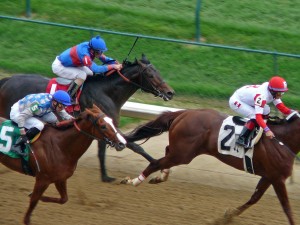 When the first Saturday in May arrives, at least 150,000 spectators fill Churchill Downs for the Kentucky Derby, long referred to as the “greatest two minutes in sports” because that’s about how long the marquee horse race lasts. This year marks the 140th run.
When the first Saturday in May arrives, at least 150,000 spectators fill Churchill Downs for the Kentucky Derby, long referred to as the “greatest two minutes in sports” because that’s about how long the marquee horse race lasts. This year marks the 140th run.
Mint juleps, the event’s signature cocktail, arrive in frosted souvenir glasses all over Louisville. Lots of ladies swank it up, wearing cocktail dresses and big, beautiful hats to the racetrack. It is customary to arrive hours before race time.
Attending the Kentucky Derby also means paying premium rates for a hotel and jockeying for elbowroom at area restaurants, bourbon bars and tourist attractions. Derby admission this year is $698 ($799 for covered seating); the two-day ticket includes Kentucky Oaks racing on Friday.
People who opt for a $50 cheap seat are in for a standing-room-only Derby day, with no chance of eyeballing any race in its entirety (except from the new, 90-foot-tall video screen). The frat-like, devil-may-care atmosphere isn’t a good match for families with children.
This all is good, if it’s more important to see the Kentucky Derby than experience Churchill Downs. But when place is more important than event, there are much less expensive ways to proceed. Within one week after the Derby, track admission is as little as $3, and reserved seats in the clubhouse start at $10.
Louisville’s horse racing season happens in three waves: April 26 to June 29, Sept. 5-28 and Oct. 26 to Nov. 30. A general admission ticket on opening night is $10: Dress to the nines or show up in jeans. Wear a fancy hat or buy one in the gift shop. You won’t be in the infield.
The crowd, throughout the racing season, sizes up thoroughbreds at the paddock before placing their bets. The outdoor music of DJs and bands fills time between races. Arrive early and tour the Kentucky Derby Museum, where artifacts and videos trace races, winners, outrageous antics and sweet traditions. See derbymuseum.org, 502-637-1111.
Derby fever builds days before the big May 3 race, and not only through high-ticket affairs. One example: Dawn at the Downs, where horse lovers watch Derby contenders exercise from 7-9 a.m. Admission is free, or pay $36 to take a seat indoors on Millionaires Row for a buffet breakfast.
At other times of year, see horses in workouts and grooming during the one-hour Barn and Backside Tour of Churchill Downs, which heads to horse stables and track rails. The cost is $11, except during Derby Week, when a ticket spikes to $40. More at churchilldowns.com, 502-636-4400.
What is there to learn? Many things. Horses run counterclockwise on the one-mile track, built in 1875. In the grounds’ 47 barns are stalls for 1,400 animals. When a siren goes off, it means a horse has lost its rider. Of the Kentucky Derby’s 139 winners, 106 were Kentucky-bred.
Guides such as Gene Logan say “manure is the smell of money” because horse racing is a $5 billion industry in Kentucky.
Kentucky Derby Festival events are an ongoing parade of fitness events, music concerts, galas, contests and fireworks. Much happens in April; check out kdf.org, 800-928-3378.
—
Almost all of the world’s bourbon is distilled in Kentucky, and Louisville’s Urban Bourbon Trail pays homage to Kentucky’s longstanding product. At least two dozen businesses – historic restaurants to edgy neighborhood bars – each sell at least 50 types of bourbon. Details are at bourboncountry.com.
Louisville also takes pride in its Hot Brown, an open-faced turkey and bacon sandwich that is topped with cheese sauce. The sandwich was introduced at the Brown Hotel in 1926, and the new Hot Brown Hop showcases at least 40 places that serve a variation of this regionally classic meal.
For more about these stops and other city sites: gotolouisville.com, 888-568-4784.
Besides Churchill Downs, sports fans flock to the Louisville Slugger Museum and Factory (sluggermuseum.org, 877-775-8443), to see how baseball bats are made; and the Muhammad Ali Center (alicenter.org, 502-584-9254), to get acquainted with the boxer’s life and legacy.
—
The U.S. Travel Association reports that 21 percent of government employees and 15 percent of private sector employees did not use all of their vacation time in 2013.
Brand USA, which promotes domestic travel, between now and July is partnering with National Geographic and international bloggers to create online travelogues about The Great American Road Trip. Follow these travels at discoveramerica.com.
Destinations will include the Pacific Coast Highway (Los Angeles to San Francisco), Blues Highway (Nashville to New Orleans), Texas Barbecue Trail (San Antonio to Austin), Hawaii’s Hana Highway in Maui, Route 66 (Chicago to Los Angeles), Great River Road (Minnesota to Louisiana), Craft Beer Trail (Montana to Arizona), Oregon Trail (Kansas City to Oregon City), New England Coast (Boston to Freeport, Maine) and Atlantic Coast (Boston to Key West).
